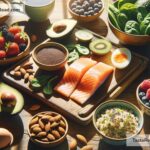Foods That Promote Healthy Menstrual Cycles
Your menstrual cycle plays a crucial role in your overall health as a woman. However, it’s not uncommon for women to experience discomfort, irregularities, or troublesome symptoms during their monthly periods. The good news is, your diet can influence your menstrual health in a positive way. Eating the right foods may help regulate your cycle, reduce cramps, boost your energy, and balance hormone levels. In this blog article, we’ll talk about simple, healthy foods you can include in your diet to help support a healthy menstrual cycle.
Why Diet Matters During Your Menstrual Cycle
Your menstrual cycle is governed by hormones—especially estrogen and progesterone—working in harmony to ensure your cycle runs smoothly. Certain foods contain important nutrients that support hormone balance, as well as reduce inflammation and improve circulation. These benefits can make your menstrual cycle less challenging to manage and more predictable.
By focusing on a nutrient-dense diet, your body will have the fuel it needs to function optimally. Let’s explore the foods that promote a healthy menstrual cycle.
1. Leafy Green Vegetables
Leafy greens like spinach, kale, and Swiss chard are packed with important nutrients such as iron, magnesium, and calcium. Menstrual bleeding can sometimes cause temporary iron deficiency, especially for women with heavy periods. Eating iron-rich vegetables helps replenish your body’s iron levels, which can reduce feelings of fatigue and dizziness.
Magnesium in leafy greens is another excellent mineral for menstrual health, helping to ease muscle cramps and calm your nervous system during your period. Adding more greens to your meals is simple—just toss them into salads, smoothies, or sautés.
2. Fruits
Fruits are excellent sources of vitamins, antioxidants, and hydration that play a role in keeping your menstrual cycle in balance. Bananas, for example, are rich in vitamin B6 and potassium, which may reduce bloating and improve mood during PMS (premenstrual syndrome). Oranges, lemons, and other citrus fruits pack a punch of vitamin C, which supports your immune system and boosts collagen production that’s essential for healthy skin during hormonal fluctuations.
Don’t forget berries like strawberries, blueberries, and raspberries! These fruits contain powerful antioxidants that help fight inflammation and reduce period-related discomfort.
3. Whole Grains
Whole grains—like oats, quinoa, and brown rice—are full of fiber, which aids in digestion and prevents bloating. Fiber helps regulate your digestive system and balance estrogen levels by removing excess hormones from your body.
Additionally, whole grains contain B vitamins, which can help reduce fatigue, improve mood, and give you the energy you need during your period. Swap out refined carbs like white bread and pasta for whole-grain alternatives to support your menstrual cycle and overall health.
4. Healthy Fats
Healthy fats are crucial for hormone production and overall health. Foods that contain omega-3 fatty acids, like salmon, walnuts, flaxseeds, and chia seeds, help reduce inflammation and alleviate menstrual pain. Studies have shown omega-3s may decrease the severity of cramps by relaxing the muscles of the uterus.
Avocados are another fantastic source of healthy fats, as well as vitamin E, which supports skin health and may help alleviate breast tenderness during PMS.
5. Iron-Rich Foods
Iron is an essential mineral during your period. Since blood loss can deplete your iron stores, eating iron-rich foods like lentils, beans, tofu, lean meats, and fortified cereals helps maintain your energy levels.
Adequate iron intake is especially important if you feel tired, weak, or sluggish during your cycle. Pairing these iron-rich foods with a source of vitamin C—like orange slices or tomatoes—can enhance iron absorption.
6. Ginger and Turmeric
Both ginger and turmeric are natural anti-inflammatories that can soothe pain and reduce bloating associated with your period. Ginger tea is excellent for relieving nausea and cramps, while turmeric’s active compound, curcumin, has been shown to support hormone balance.
These spices are easy to incorporate into soups, stir-fries, or warm beverages during your period.
7. Dark Chocolate
Here’s good news for chocolate lovers—dark chocolate is a great treat during your menstrual cycle! Choose dark chocolate that’s at least 70% cocoa, as it’s high in magnesium and antioxidants. Magnesium can help ease cramps and boost your mood during PMS.
Keep portions reasonable, and make sure you’re eating high-quality dark chocolate instead of sugar-packed candy bars.
8. Probiotic-Rich Foods
A healthy gut is key to balancing hormones, and eating foods rich in probiotics can support gut health. Yogurt, kefir, kimchi, and sauerkraut contain natural probiotics that promote digestion, reduce bloating, and improve overall health. A healthy gut can also improve your body’s ability to metabolize estrogen.
9. Water
While it’s not technically a “food,” staying hydrated is incredibly important during your menstrual cycle. Drinking plenty of water helps reduce bloating, combats fatigue, and keeps your body functioning properly. Herbal teas like chamomile or peppermint are also great options for hydration and relaxation.
Final Thoughts
Your diet plays a key role in how you feel during your menstrual cycle. By including nutrient-rich foods that promote hormone balance, fight inflammation, and support energy levels, you can help your body handle the challenges of menstruation more effectively.
Remember, everyone’s body is different, so you might find that certain foods work better than others for you. Pay attention to how your body reacts and consider keeping a food diary to track what helps ease your symptoms. Let food be your ally in achieving a healthier, smoother menstrual cycle!


